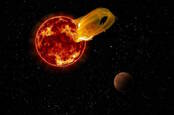This article is more than 1 year old
16 exoplanets found huddled around 12 lightweight stars
One of the 'super-Earth' finds might even have liquid water
A team of astronomers have spotted 16 exoplanets, including a ‘super-Earth’ that might hold liquid water, hovering around 12 low mass stars hundreds of light years away from the Solar System.
One of the most luminous red dwarf stars, codenamed K2-155, in the dozen is of particular interest. Located about 200 light years away, it is orbited by three ‘super-Earths’ - planets that are slightly more massive than the Earth.
The researchers reckon the super-Earth furthest away from star, known as K2-155d, might lie in the so-called "Goldilocks" habitable zone where liquid water could form on its surface because the temperature is neither too hot or too cold. The results were published in The Astrophysical Journal in February.
“In our simulations, the atmosphere and the composition of the planet were assumed to be Earth-like,” but “there's no guarantee that this is the case," Teruyuki Hirano, first author of the paper and an assistant professor at the Department of Earth and Planetary Sciences at the Tokyo Institute of Technology, said in a statement on Monday.
Hirano has good reason to be skeptical. Being in the habitable zone is a good start, but there are a whole host of other factors that need to be considered for life to survive.
Scientists were bubbling with excitement when Proxima b, the closest exoplanet in a habitable zone also orbiting a red dwarf star, Proxima Centauri, was discovered in 2016. It was identified as a target for future flyby missions.
But although it lay in the special Goldilocks region, later studies found that the chances of life were low as it has probably been blasted by huge, deadly solar flares.
Astronomers will have to calculate K2-155d’s radius and temperature to see if it really is habitable.
Fifteen of the 16 exoplanets studied circled around red dwarf stars. “It's important to note that the number of planets around red dwarfs is much smaller than the number around solar-type stars. Red dwarf systems, especially coolest red dwarfs, are just beginning to be investigated, so they are very exciting targets for future exoplanet research," said Hirano.
Scientists aren’t quite sure of the exact reason. But it could be down to photoevaporation, a process that can strip away a planet’s atmosphere.
"Large planets are only discovered around metal-rich stars and what we found was consistent with our predictions. The few planets with a radius about three times that of Earth were found orbiting the most metal-rich red dwarfs," said Hirano.
The studies analysed the data from NASA’s Kepler Space Telescope on its K2 mission. NASA is also launching its Transiting Exoplanet Survey Satellite (TESS), a two year mission to scout out exoplanets around the brightest stars close to Earth.
“TESS is expected to find many candidate planets around bright stars closer to Earth. This will greatly facilitate follow-up observations, including investigation of planetary atmospheres and determining the precise orbit of the planets, " Hirano concluded. ®

